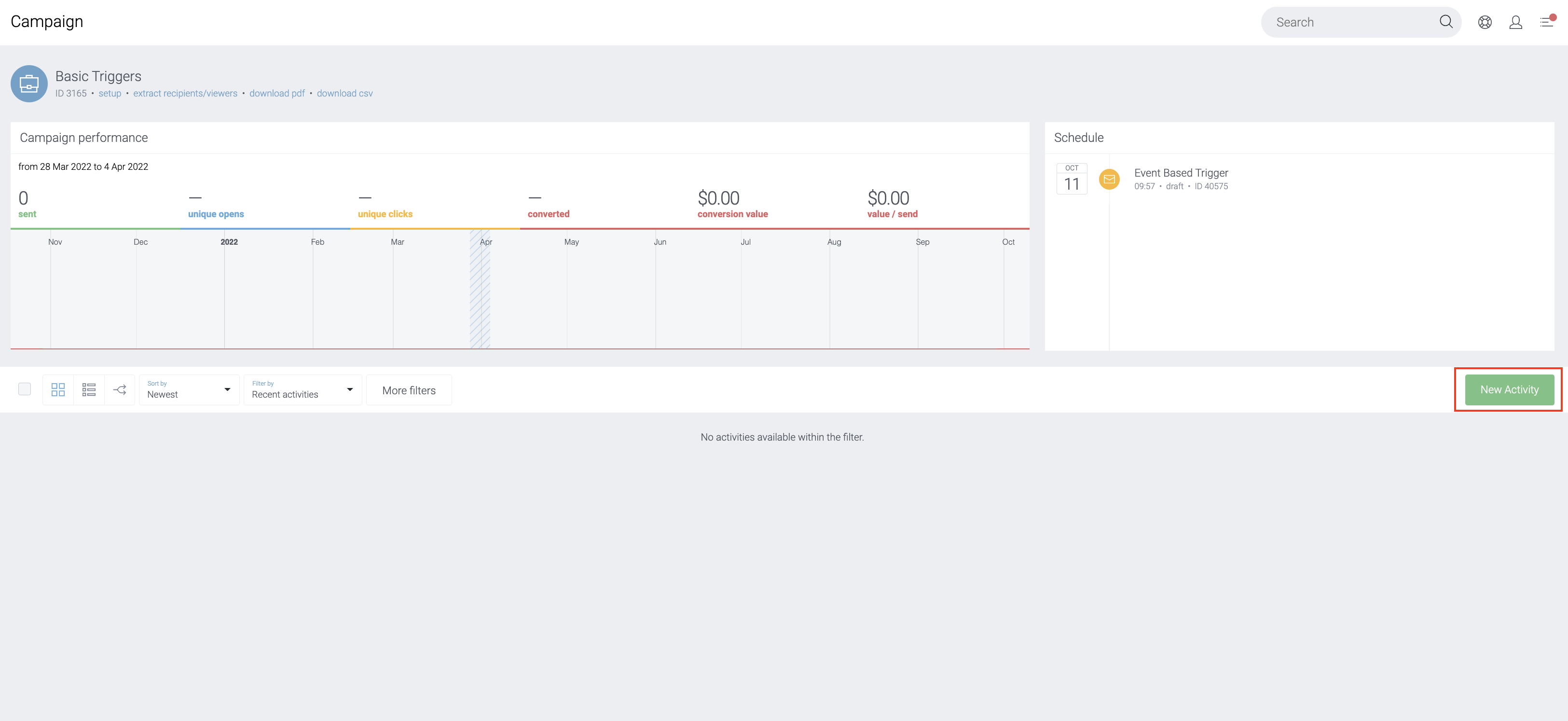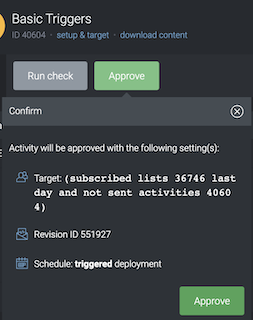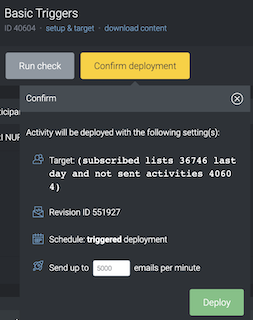- Support Home
- Knowledge Base
- Triggers And Automation
- Basic Triggers
- Welcome Trigger (Basic Scheduled Trigger)
Welcome Trigger (Basic Scheduled Trigger)
Sending a 'Welcome' email to your subscribers is a great introduction for your newly acquired subscribers. You can choose to send a welcome trigger hourly or daily.
Suggested Set-up
| Send Date / Time | User defined. |
| Repeat | Select either 'Hourly' to trigger every hour or 'Daily' to trigger once per day. |
| Target Expression | subscribed list X last hour and not sent activity Yor subscribed list X last day and not sent activity YLearn more about these target expressions |
Instructions
Step 1: Activity Set-up
Begin by either setting up a new activity, or editing an existing activity. We recommend keeping your triggers separate from other emails in their own campaign folder.
If you are setting up a new activity, click the 'New Activity' button in a campaign folder to set up a new activity. A setup screen will appear.

If you are editing an existing activity, simply navigate to the setup screen by either clicking 'setup' in the activity card actions or within the activity header.

The setup screen will appear with activity options. From here you can set the following options:
- Distribution Type: Scheduled trigger
- Date: Select your own date and time for when you wish the trigger to start. The most important part is the time as this will be used by the repetition option to determine when to send the trigger each hour.
- Trigger Interval: Choose 'Hourly', 'Daily', 'Weekly' or 'Monthly' depending on your intended trigger schedule.
- Subscriber Send Frequency: In this field, you can pick an option between 'send only once' or 'send once' every day/weeks/months/year. In this example, we will pick 'send only once' as a follow-up to target new subscribers that were sent a 'Welcome' activity the day before.
- Send Limit: You can use this field if you know how many recipients an activity should be sent to each time and you don't want to send it if there are more recipients than expected. If you leave this field blank, then this send limit won't apply. For instance, if there are 500 in this field and it targets subscriber list X which includes 1000 subscribers, the activity will not be sent at all.
Note: send limit should only be used for triggers and not immediate or scheduled broadcasts
Save the changes you make by clicking the save button.
Step 2: Edit Activity Content
You can then begin editing your activity content. View the V5 User Guide for tips on creating your activity content.
This is a good opportunity to try multivariate or a/b split testing on your content to find out which combination performs better.
Step 3: Set Target Expression
Click on the 'target' link within the activity header, the target expression builder will appear. Simply paste the following target expression into the input field at the top:
subscribed list X last hour and not sent activity Y
This target expression will target those within subscriber list X (change to a subscriber list ID) who were added within the last hour and who have not received activity Y (change to the current activity ID). Paired with the 'Hourly' repetition option, this will capture those subscribers who are newly acquired.
If you wish to target a subscriber on a daily schedule rather than hourly, use the following target expression along with the 'Daily' repetition option:
subscribed list X last day and not sent activity X
This target expression will target those within subscriber list X (change to a subscriber list ID) who were added within the last day and who have not received activity Y (change to the current activity ID). Paired with the 'Daily' repetition option, this will capture those subscribers who are newly acquired but on a less frequent schedule (sent daily rather than hourly).
For more information on target expressions and more birthday target expression options, please refer to the Target Expression Reference.
If you set a frequent repetition cycle, remember to exclude subscribers who have already received the activity, otherwise the trigger will contine to send to the same subscribers. You can do this by adding
not sent activity X last Y daysto the target expression (where X is the activity ID).
Approve and Deploy
Approve and deploy your activity to initiate the trigger. If you have scheduled a date/time in future, it will commence broadcasting the trigger on that date/time.
- Click on 'Approve' to approve the activity. A pop-up modal will appear showing your target expression, revision ID and your schedule.

- Once approved, a 'Confirm Deployment' button should appear in the activity panel. Click on the button to confirm your target expression, revision ID, schedule and the throttle limit.

- After it's been deployed, two red buttons showing 'Cancel Deployment' and 'Suspend' should appear. The throttle rate will be displayed together with the number sends that have yet to be broadcasted.

Several sample triggers are available, please refer to the Trigger Examples.
Step 1: Activity Set-up
Begin by either setting up a new activity, or editing an existing activity. We recommend keeping your triggers separate from other emails in their own campaign folder.
If you are setting up a new activity, click the '+' icon in the top right of a campaign folder
If you are editing an existing activity, navigate to the activity you wish to trigger and select the 'Edit' button in the top right corner of your screen.
A modal window will appear with activity options. From here you can set the following options:
- Date: Select your own date and time for when you wish the trigger to start. The most important part is the time as this will be used by the repetition option to determine when to send the trigger each hour.
- Repeat: Choose 'Hourly' or 'Daily' depending on your intended trigger schedule.
Save the changes you make by clicking the save button.
Step 2: Edit Activity Content
You can then begin editing your activity content. View the V4 User Guide for tips on creating your activity content.
This is a good opportunity to try multivariate or a/b split testing on your content to find out which combination performs better.
Step 3: Set Target Expression
Click on the Select Recipients... button under Distribution Settings. Click the 'Advanced' tab and paste the following target expression into the field:
subscribed list X last hour and not sent activity Y
This target expression will target those within subscriber list X (change to a subscriber list ID) who were added within the last hour and who have not received activity Y (change to the current activity ID). Paired with the 'Hourly' repetition option, this will capture those subscribers who are newly acquired.
If you wish to target a subscriber on a daily schedule rather than hourly, use the following target expression along with the 'Daily' repetition option:
subscribed list X last day and not sent activity X
This target expression will target those within subscriber list X (change to a subscriber list ID) who were added within the last day and who have not received activity Y (change to the current activity ID). Paired with the 'Daily' repetition option, this will capture those subscribers who are newly acquired but on a less frequent schedule (sent daily rather than hourly).
For more information on target expressions and more birthday target expression options, please refer to the Target Expression Reference.
If you set a frequent repetition cycle, remember to exclude subscribers who have already received the activity, otherwise the trigger will contine to send to the same subscribers. You can do this by adding
not sent activity X last Y daysto the target expression (where X is the activity ID).
Step 4: Approve and Deploy
Approve and deploy your activity to initiate the trigger. If you have scheduled a date/time in future, it will commence broadcasting the trigger on that date/time.

